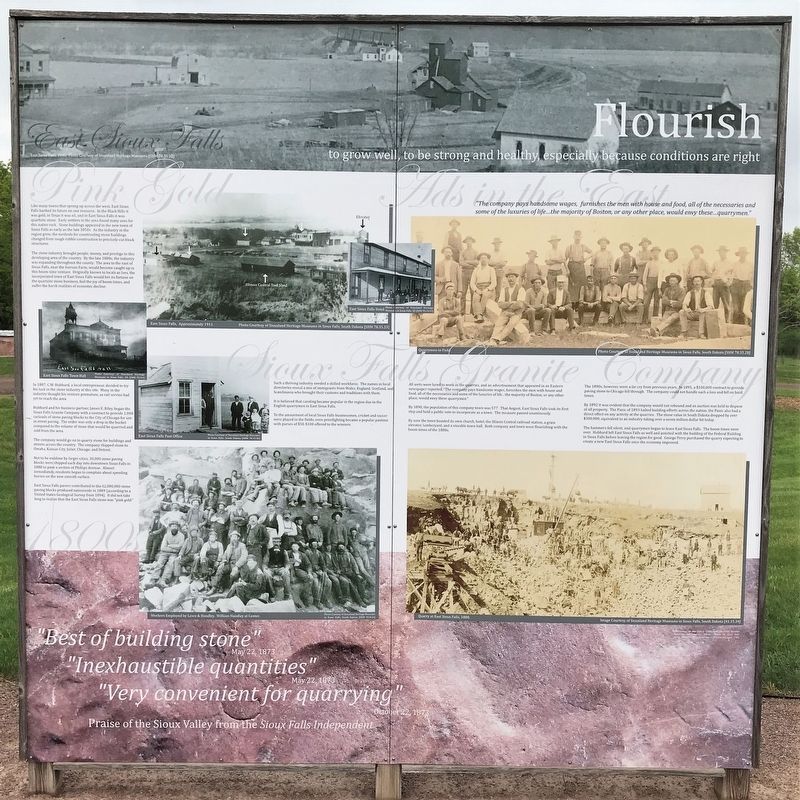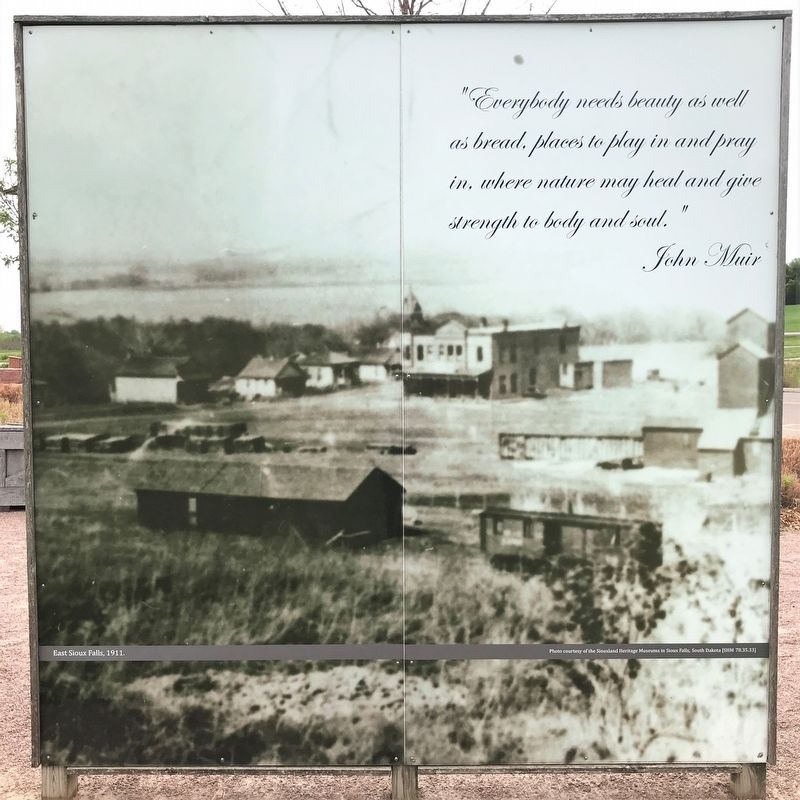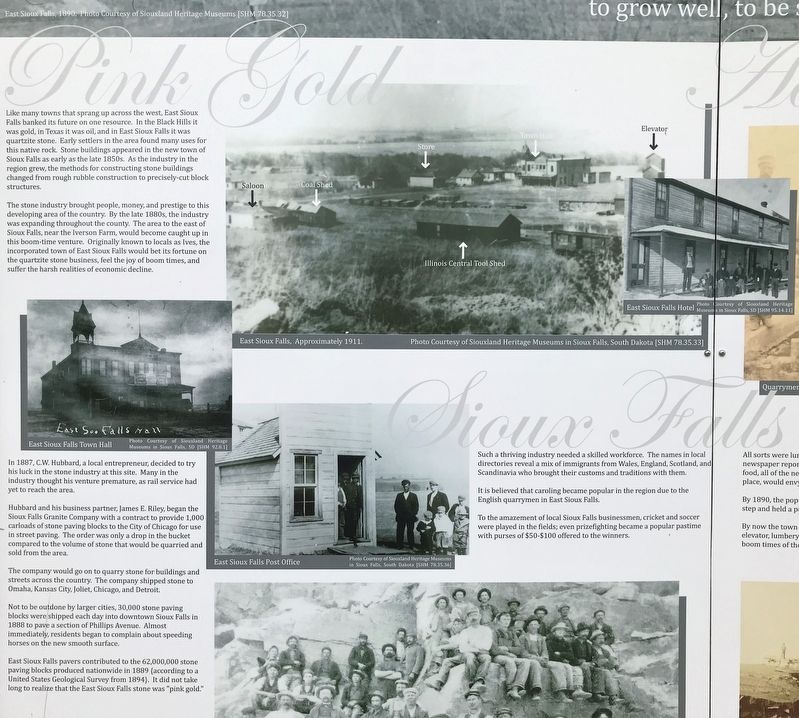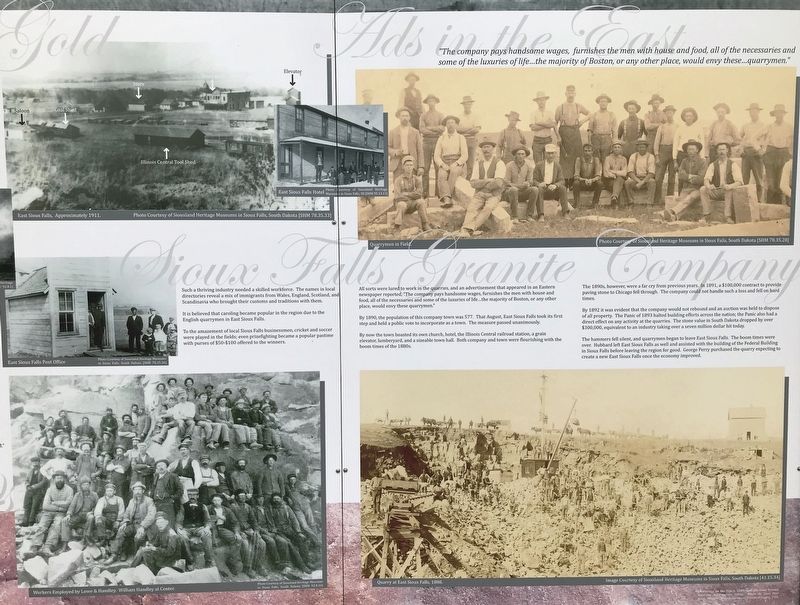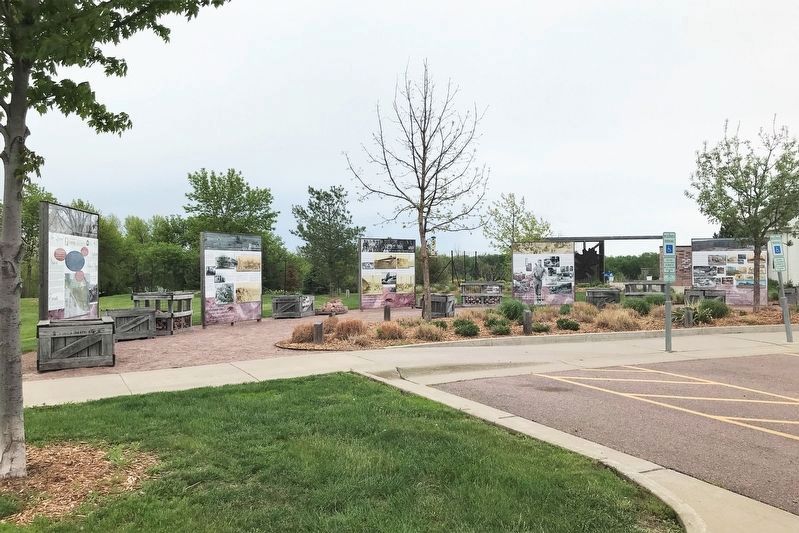Sioux Falls in Minnehaha County, South Dakota — The American Midwest (Upper Plains)
Flourish
header:
East Sioux Falls
East Sioux Falls, 1890. Photo Courtesy of Siouxland Heritage Museums [SHM 78.35.32]
Pink Gold
Like many towns that sprang up across the west, East Sioux Falls banked its future on one resource. In the Black Hills it was gold, in Texas it was oil, and in East Sioux Falls it was quartzite stone. Early settlers in the area found many uses for this native rock. Stone buildings appeared in the new town of Sioux Falls as early as the late 1850s. As the industry in the region grew, the methods for constructing stone buildings changed from rough rubble construction to precisely-cut block structures.
The stone industry brought people, money, and prestige to this developing area of the country. By the late 1880s, the industry was expanding throughout the county. The area to the east of Sioux Falls, near the Iverson Farm, would become caught up in this boom-time venture. Originally known to locals as Ives, the incorporated town of East Sioux Falls would bet its fortune on the quartzite stone business, feel the joy of boom times, and suffer the harsh realities of economic decline.
photos:
East Sioux Falls, Approximately 1911.
Photo Courtesy of Siouxland Heritage Museums in Sioux Falls, South Dakota [SHM 78.35.33]
East Sioux Falls Hotel
Photo Courtesy of Siouxland Heritage Museums in Sioux Falls, SD [SHM 95.14.11]
East Sioux Falls Town Hall
Photo Courtesy of Siouxland Heritage Museums in Sioux Falls, SD [SHM 92.8.1]
East Sioux Falls Post Office
Photo Courtesy of Siouxland Heritage Museums in Sioux Falls, South Dakota [SHM 78.35.36]
In 1887, C.W. Hubbard, a local entrepreneur, decided to try his luck in the stone industry at this site. Many in the industry thought his venture premature, as rail service had yet to reach the area.
Hubbard and his business partner, James E. Riley, began the Sioux Falls Granite Company with a contract to provide 1,000 carloads of stone paving blocks to the City of Chicago for use in street paving. The order was only a drop in the bucket compared to the volume of stone that would be quarried and sold from the area.
The company would go on to quarry stone for buildings and streets across the country. The company shipped stone to Omaha, Kansas City, Joliet, Chicago, and Detroit.
Not to be outdone by larger cities, 30,000 stone paving blocks were shipped each day into downtown Sioux Falls in 1888 to pave a section of Phillips Avenue. Almost immediately, residents began to complain about speeding horses on the new smooth surface.
East Sioux Falls pavers contributed to the 62,000,000 stone paving blocks produced nationwide in 1889 {according to a United States Geological Survey from 1894}. It did not take long to realize that the East Sioux Falls stone was "pink gold."
1800s
photo:
Workers Employed by Lowe & Handley. William Handley at Center.
Photo Courtesy of Siouxland Heritage Museums in Sioux Falls, South Dakota [SHM 92.8.16]
Ads in the East
"The company pays handsome wages, furnishes the men with house and food, all of the necessaries and some of the luxuries of life...the majority of Boston, or any other place, would envy these...quarrymen."
photo:
Quarrymen in Field.
Photo Courtesy of Siouxland Heritage Museums in Sioux Falls, South Dakota [SHM 78.35.28]
Sioux Falls Granite Company
Such a thriving industry needed a skilled workforce. The names in local directories reveal a mix of immigrants from Wales, England, Scotland, and Scandinavia who brought their customs and traditions with them.
It is believed that caroling became popular in the region due to the English quarrymen in East Sioux Falls.
To the amazement of local Sioux Falls businessmen, cricket and soccer were played in the fields; even prizefighting became a popular pastime with purses of $50-$100 offered to the winners.
All sorts were lured to work in the quarries, and an advertisement that appeared in an Eastern newspaper reported, "The company pays handsome wages, furnishes the men with house and food, all of the necessaries and some of the luxuries of life...the majority of Boston, or any other place, would envy these quarrymen."
By 1890, the population of this company town was 577. That August, East Sioux Falls took its first step and held a public vote to incorporate as a town. The measure passed unanimously.
By now the town boasted its own church, hotel, the Illinois Central railroad station, a grain elevator, lumberyard, and a sizeable town hall. Both company and town were flourishing with the boom times of the 1880s.
The 1890s, however, were a far cry from previous years. In 1891, a $100,000 contract to provide paving stone to Chicago fell through. The company could not handle such a loss and fell on hard times.
By 1892 it was evident that the company would not rebound and an auction was held to dispose of all property. The Panic of 1893 halted building efforts across the nation; the Panic also had a direct effect on any activity at the quarries. The stone value in South Dakota dropped by over $300,000, equivalent to an industry taking over a seven million dollar hit today.
The hammers fell silent, and quarrymen began to leave East Sioux Falls. The boom times were over. Hubbard left East Sioux Falls as well and assisted with the building of the Federal Building in Sioux Falls before leaving the region for good. George Perry purchased the quarry expecting to create a new East Sioux Falls once the economy improved.
photo:
Quarry at East Sioux Falls, 1888.
Image Courtesy of Siouxland Heritage Museums in Sioux Falls, South Dakota [41.15.34]
"Best of building stone"
May 22, 1873
"Inexhaustible quantities"
May 22, 1873
"Very convenient for quarrying"
October 22, 1873
Praise of the Sioux Valley from the Sioux Falls Independent
Information on this Sign is Courtesy of Siouxland Heritage Museums and Fanebust, Wayne. Where the Sioux River Bends. Freeman: Minnehaha County Historical Society, 1985.
Back:
"Everybody needs beauty as well as bread, places to play in and pray in, where nature may heal and give strength to body and soul."
John Muir
East Sioux Falls, 1911.
Photo courtesy of the Siouxland Heritage Museums in Sioux Falls, South Dakota [SHM 78.35.33]
Topics. This historical marker is listed in these topic lists: Industry & Commerce • Settlements & Settlers. A significant historical year for this entry is 1887.
Location. 43° 31.635′ N, 96° 36.382′ W. Marker is in Sioux Falls, South Dakota, in Minnehaha County. Marker is on South Perry Place, 0.1 miles north of State Highway 42, on the right when traveling north. Located at the Mary Jo Wegner Arboretum & East Sioux Falls Historic Site. Touch for map. Marker is at or near this postal address: 1900 S Perry Pl, Sioux Falls SD 57110, United States of America. Touch for directions.
Other nearby markers. At least 8 other markers are within walking distance of this marker. bud (here, next to this marker); Wilt (here, next to this marker); Seed (here, next to this marker); Sprout (a few steps from this marker); fruit (a few steps from this marker); Disperse (a few steps from this marker); vegetate (within shouting distance of this marker); unearth (within shouting distance of this marker). Touch for a list and map of all markers in Sioux Falls.
Credits. This page was last revised on June 2, 2022. It was originally submitted on June 1, 2022. This page has been viewed 172 times since then and 78 times this year. Photos: 1, 2, 3, 4, 5. submitted on June 1, 2022.
